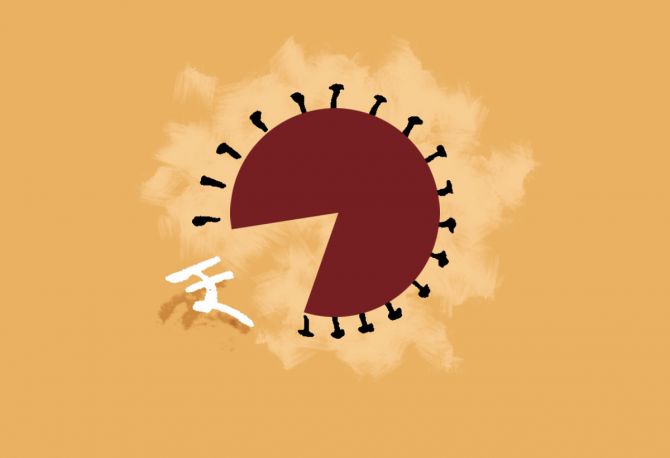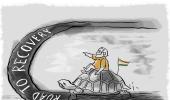'With the June quarter GDP shrinking by nearly a quarter, there is an even greater economic imperative: Reduction of uncertainty,' observes Neelkanth Mishra.

The pandemic, much less fatal than earlier feared, is now beyond control, but the economy can still be helped.
The COVID-19 pandemic count continues to grow in India, but most concurrent indicators of economic activity continue to inch up.
The pace of improvement has slowed sharply, but the steady upward grind is visible, helped along by progressive easing of central regulations and despite somewhat haphazard and hard-to-understand lockdowns imposed locally across several districts and states.
Has the economy de-linked itself from the virus?
The daily growth rate of confirmed cases has slowed to less than 2.5 per cent a day, but this measure now has limited relevance in tracking the disease's advance: Seroprevalence studies in several major Indian cities have shown infection rates to be 20 to 50 times higher than the reported cases.
These studies look for the presence of COVID-19 antibodies in the blood serum -- hence the term 'seroprevalence' -- which if found are a tell-tale sign that someone has had an infection.
The large numbers reported in these studies show that the current testing infrastructure is missing many infections, reducing the analytical utility of daily case numbers.
Sero studies can help in charting the pandemic's geographic spread through the districts (assuming that the level of under-counting is similar across the country), but given the divergent positive test ratios in several states and districts (some too high, and some low), even such comparisons are likely to be flawed.
Daily reported deaths ascribed to COVID-19 have stagnated between 900 and 1,100 a day, an unacceptably high level in absolute terms, but only 4 per cent of all-cause mortality in India.
Notwithstanding concerns about significant under-reporting of deaths (again a problem not unique to India), the seroprevalence studies report infection fatality rates (IFR) below one-tenths of a per cent (that is, one death in one thousand infections), which is a fraction of the case fatality rate (CFR) that is tracked regularly and reported in newspapers (an infection becomes a case only when the patient tests positive).
That 30 to 50 per cent of the population in cities like Delhi, Mumbai and Pune have already had infections, and reported case numbers have fallen well below their peaks, is encouraging.
After new cases and deaths plummeted in Delhi, it was hoped that while pandemic curtailment appeared to be beyond our collective administrative capabilities, in a few months the disease could blow over.
Thus, even as the number of districts reporting a hundred or more new cases a day climbed steadily, at some point it would naturally end.
As the fatality rate was much lower than earlier feared, one could reach this end point without too many lives lost.
But that was too good to be true.
When a pandemic truly 'blows over', the case numbers do not just stagnate, but plummet, like they did in New York, or even in the Amazonian town of Manaus in Brazil.
In Mumbai, given the lack of sufficient testing, as reflected in a high positive ratio, we have been tracking the number of oxygen beds occupied.
This rose steadily through May and June, but started to plateau at about 6,300 in July, and then started to fall.
However, it did not decline below 5,400 for several weeks (the last reported number we found was August 17).
Similarly, despite seroprevalence studies showing nearly 50 per cent infection rates in Pune, the daily number of new cases and deaths remains elevated.
Even as our collective understanding of the virus improves, global as well as local reports of reinfections -- some within six weeks -- and a recent National Centre for Disease Control (NCDC) study that found no antibodies in the blood of 97 out of 208 people who had previously tested positive, show that the immunity provided by antibodies may not last long.
This could be due to short-lived antibodies (the NCDC called this immune response 'transient in nature'), or because there are multiple strains of virus now.
This challenges the notion of 'herd immunity' through natural infections, and raises important questions for some of the vaccines under development as well.
Given that we can no longer pray for a natural ebbing of the pandemic, we may have to live with the virus till a vaccine comes.
With the earlier attempted strategy of contact tracing and controlling the spread no longer a practical option, what does this mean for the economy?
Many economic activities that involve human contact in a closed environment, like schooling or eating out, may see continued curtailment for several more months, despite the intention of the government to permit as many activities as possible.
Perhaps more importantly, as the open-but-nearly-empty malls in our neighbourhood, as well as the near doubling of e-commerce users in India demonstrate, fear among the people may take several months to go away, likely making it a gradual process.
Statistically, there will always be a more venturesome part of the population willing to take more risks, either out of the need to earn, or just out of lockdown fatigue.
However, for economic normalcy this needs to extend to the whole population, not just a fraction.
With the June quarter gross domestic product shrinking by nearly a quarter, there is an even greater economic imperative: Reduction of uncertainty on two fronts.
The supply side administrative measures that have limited proven efficacy like weekend lockdowns or on random days, measures that last a week, and arbitrary restrictions on movement of goods and people, add to the economic uncertainty and engender supply shortages that among other things drive inflation, creating disruptions in financial markets.
On the demand side, even as restocking of supply chains and expression of pent-up demand in the ongoing festive season improve some concurrent indicators, there is still a nagging fear, if not an expectation, that this would abate in a few months.
Consumption and investment sentiment in the private sector tends to be backward looking when assessing prospects, but given the natural optimism of entrepreneurs, a commitment to strong economic growth from the government through fiscal and policy measures would go a long way in reviving the animal spirits that can help offset the now unresolvable-without-a-vaccine pandemic.
Neelkanth Mishra is co-head of APAC Strategy and India Strategist for Credit Suisse.
Feature Presentation: Aslam Hunani/Rediff.com











